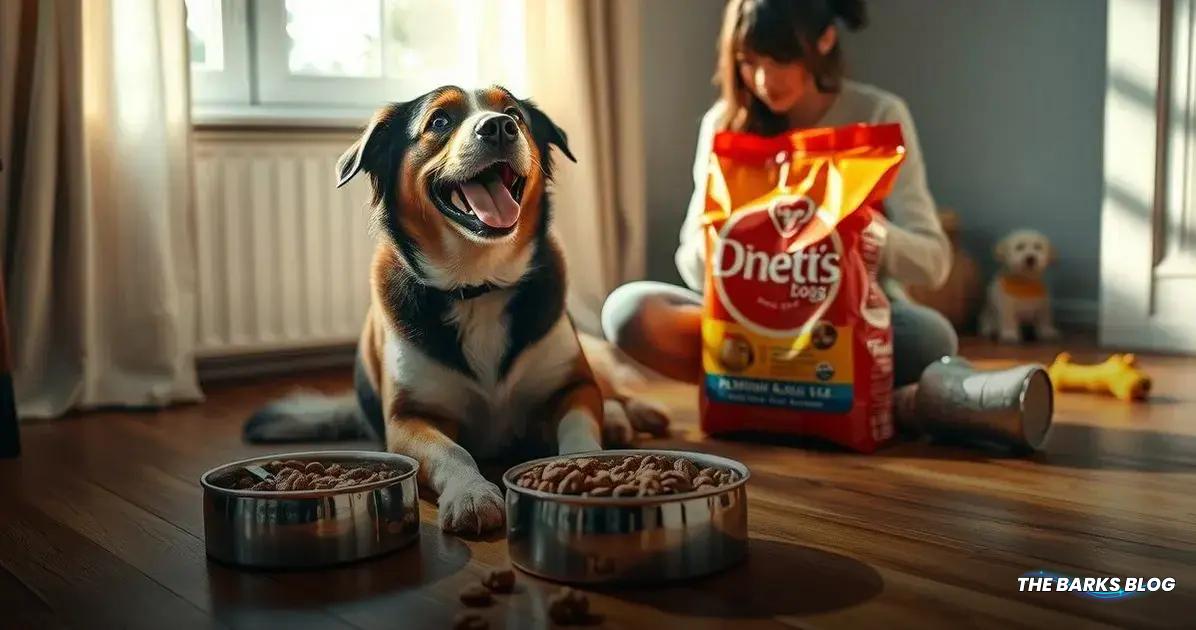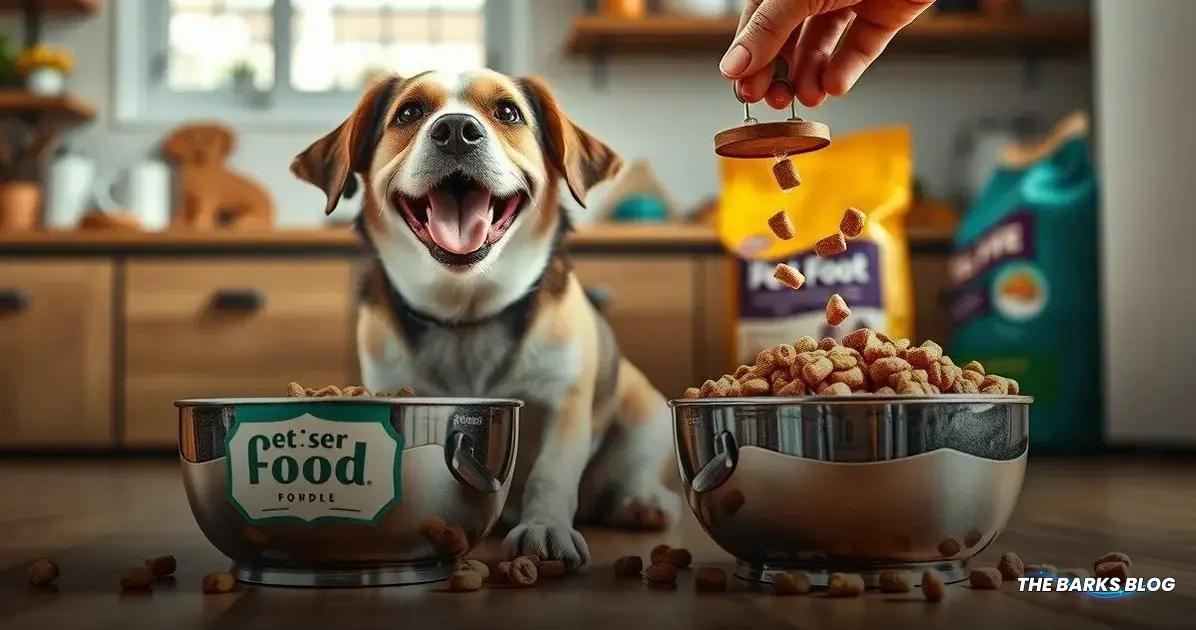When changing your dog’s food, it’s important to do so gradually to avoid health issues. Reasons for switching may include veterinary advice, changes in life stage, food allergies, lifestyle changes, or a preference for better ingredients. Symptoms of food allergies can include gastrointestinal problems, skin issues, ear infections, and behavioral changes. To transition your dog, mix the new food with the old food over several days while observing their reaction, and consult a veterinarian if any problems occur. A proper diet can enhance your dog’s overall well-being.
When it comes to caring for your dog, getting their diet right is crucial. Switching your dog’s food can be a delicate process, and understanding their needs is key. In this guide, we’ll share tips on how to transition your dog’s food without causing any tummy troubles.

Reasons to Change Your Dog’s Food
There are several important reasons why you might need to change your dog’s food. Understanding these reasons can help you make informed decisions about your pup’s diet.
1. Veterinary Recommendations: Sometimes, your vet may advise you to switch your dog’s food due to health concerns or specific dietary needs. This could be due to weight management, allergies, or digestive issues.
2. Life Stage Changes: As dogs grow, their nutritional needs change. Puppies require different nutrients than adult dogs, and senior dogs may need food that supports joint health and overall vitality. Transitioning to age-appropriate food is essential for their well-being.
3. Food Allergies or Sensitivities: If your dog is showing signs of food allergies—like itching, gastrointestinal upset, or skin issues—it may be time to explore hypoallergenic or limited-ingredient diets. Identifying and eliminating allergens can lead to a healthier, happier dog.
4. Change in Lifestyle: If your dog’s activity level changes significantly—perhaps they become more or less active due to age or health—adjusting their food to match their energy expenditure is crucial. This helps maintain a healthy weight and overall health.
5. Quality of Ingredients: You may decide to switch foods simply to provide higher-quality ingredients for your dog. If you find a brand that offers better nutrition or more natural ingredients, making the switch can benefit your dog’s health in the long run.
In conclusion, keeping an eye on your dog’s health and lifestyle will help you determine when it’s time to change their food. Always consult with your veterinarian to ensure that any dietary changes are safe and appropriate for your furry friend.

How to Change Dog Food Gradually
Changing your dog’s food gradually is the best way to ensure a smooth transition and minimize the risk of digestive upset. Here’s how to do it effectively:
1. Start Slowly: Begin by mixing a small amount of the new food with your dog’s current food. A good starting point is a ratio of 25% new food to 75% old food. This allows your dog’s digestive system to adjust without overwhelming it.
2. Increase Gradually: After a few days, if your dog is tolerating the mix well, gradually increase the proportion of new food. Move to 40% new food and 60% old food. Continue this process over the course of about a week or more, depending on how your dog is responding.
3. Monitor Your Dog: Keep an eye on your dog during this transition. Watch for any signs of digestive upset, such as vomiting or diarrhea. If your dog shows any adverse reactions, slow down the transition process and give them more time to adjust to the new food.
4. Adjust Based on Behavior: If your dog seems to be enjoying the new food and is eating it without hesitation, you can continue to increase the amount of new food. However, if they are hesitant or refuse to eat, consider extending the time at each ratio before moving on to the next.
5. Maintain Consistent Meal Times: Establishing regular meal times can help your dog feel more comfortable with the new food. If they know when to expect their meals, they may be more inclined to eat the new food when it’s offered.
By following these steps, you can help ensure that your dog makes a successful transition to their new food without any unnecessary stress or digestive issues. Remember, patience is key during this process!

Signs of Food Allergies in Dogs
Recognizing the signs of food allergies in dogs is crucial for their health and well-being. Here are some common symptoms to watch out for:
1. Gastrointestinal Issues: One of the most common signs of food allergies is gastrointestinal upset. This can manifest as vomiting, diarrhea, or excessive gas. If your dog frequently experiences these issues after eating, it may indicate a food intolerance or allergy.
2. Skin Problems: Dogs with food allergies often exhibit skin-related symptoms. Look for signs such as itching, redness, rashes, or hot spots. Allergies can lead to excessive scratching or biting at the skin, which can result in secondary infections.
3. Ear Infections: Frequent ear infections can be a sign of food allergies. If your dog has recurrent ear infections, especially if they are accompanied by itching or a foul odor, it’s worth discussing with your veterinarian.
4. Hair Loss: Sudden or patchy hair loss can be a symptom of food allergies. If your dog is losing fur, particularly around the face, ears, or paws, it may be time to evaluate their diet.
5. Behavioral Changes: Sometimes, food allergies can affect a dog’s behavior. If your dog seems more irritable, anxious, or lethargic after eating, it might be a reaction to their food. Changes in appetite can also occur, with some dogs refusing to eat or showing a decreased interest in food.
6. Chronic Paw Licking: If your dog is constantly licking their paws, it may indicate an allergic reaction. This behavior can lead to irritation and infection, so it’s important to address the underlying cause.
If you notice any of these signs in your dog, it’s essential to consult your veterinarian. They can help determine if your dog has a food allergy and guide you on the best dietary changes to relieve their symptoms.
Conclusion
Switching your dog’s food can be a necessary but delicate process. By understanding the reasons for making a change and recognizing the signs of food allergies, you can ensure your furry friend receives the best nutrition possible.
Remember to make the transition gradually to avoid any digestive upset, and always keep an eye on your dog’s behavior and health during the process.
If you suspect your dog has food allergies, consulting with your veterinarian is crucial for finding the right diet that meets their needs.
With the right approach, you can help your dog thrive on their new food and enjoy a happy, healthy life!
FAQ – Frequently Asked Questions about Changing Dog Food
What are the signs that my dog may have a food allergy?
Common signs of food allergies in dogs include gastrointestinal issues like vomiting and diarrhea, skin problems such as itching and rashes, ear infections, hair loss, behavioral changes, and chronic paw licking.
How should I transition my dog’s food?
To transition your dog’s food, start by mixing a small amount of the new food with their current food. Gradually increase the new food over a week or more, monitoring for any signs of digestive upset.
Why might I need to change my dog’s food?
You may need to change your dog’s food for various reasons, including veterinary recommendations, changes in life stage, suspected food allergies, lifestyle changes, or to provide higher-quality ingredients.
What should I do if my dog refuses to eat the new food?
If your dog refuses to eat the new food, try making it more appealing by adding dog-safe toppings or gravy. Ensure you maintain strict meal times to encourage them to eat.
How long does it take for a dog to adjust to new food?
It can take anywhere from a few days to a few weeks for a dog to adjust to new food, depending on the individual dog and how gradually the transition is made.
When should I consult a vet about my dog’s diet?
You should consult a vet if you notice any signs of food allergies, if your dog has persistent gastrointestinal issues, or if you are unsure about the best food options for your dog’s specific needs.




